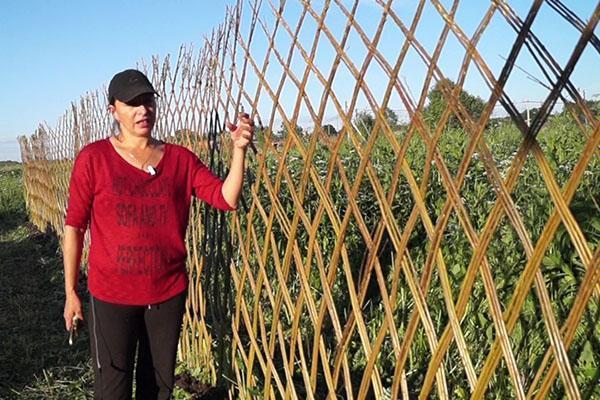Weaving willow hedges
 Willow is an excellent material for creating a hedge. To decorate it, you can use tall trees, which will act as columns. In order for a hedge to look beautiful, you need to choose the right weaving technique.
Willow is an excellent material for creating a hedge. To decorate it, you can use tall trees, which will act as columns. In order for a hedge to look beautiful, you need to choose the right weaving technique.
There are three types hedges from the willow. All of them are suitable for plots of different sizes. According to the weaving technique, hedges are divided:
- for weaving, consisting of one rod (1X1);
- weaving with two guide lines (2X2);
- weaving patterns (3X3).
Weaving with patterns is considered the most beautiful. This technique is only used if each element consists of three willow twigs. In this case, the cost of the fence increases, so it is better to equip a hedge with patterns in areas of a small area.
Which rod to choose
For weaving hedges, willow twigs with a minimum thickness of 3 mm are suitable. It is also necessary to choose rods of the same length, at least 3.2 m, in order to make a hedge with a height of 1.8 m.
You cannot grow willow twigs suitable for weaving hedges on your own. A single plant produces very few twigs 3.2 m long. Short twigs can be used to weave furniture and baskets, but they will not work for hedges.
For weaving 1 m of hedge using patterns, it takes from 30 to 45 rods. In order to grow the material necessary for arranging a hedge, you need to plant a large area with willow.
For weaving a hedge, willow twigs of the American variety are suitable. This plant forms strong, high twigs that grow up to 4 m.
How to rooting twigs
In order for the openwork hedge to take root and flourish, it is necessary to properly root the rods. For this, before planting in open ground, "revitalize the rods" is carried out. They are placed in water at room temperature for up to 48 hours.
The process of "revitalization" will start the sap flow inside the twig, which will facilitate the weaving of the openwork fence. In addition, "revitalization" will accelerate the formation of the root system.
It is undesirable to overexpose the rods in water. If the twig takes root into the water, then when transplanting into open ground, there is a high risk of damaging its root system. Broken-down rods will not take root.
The ideal state of the hedge rods is the appearance of white dots on the bark. Willow roots will form from them.
The rods are planted in the furrow to a depth of more than half of the rod. The minimum depth is 40 cm. In this case, the root system of the hedge will be powerful, which will allow you to water less often, unlike other plants in your area. The willow will receive all the necessary moisture during the rain. Willow is not demanding on the composition of the soil, so the twigs can grow without fertilizers.
After planting the twigs in open ground, cover them with three layers of mulch. In this case, you will create a good microclimate for their rooting.
The first layer of mulch is made from cut grass. Layer thickness - 2-3 cm. The second layer of mulch is soil. The thickness of the soil layer is 5 cm. Then the soil is covered with another layer of grass 2-3 cm thick.
Hedge care
After the first leaves have appeared on the hedge, it is necessary to prune.
Pruning after the first foliage bud is required. If you do not trim the hedge in the first year, the fence will start branching.
After the first cut, the mulch under the hedge must be replaced.For new mulch, you can use the same layer cake as when rooting twigs, and you can also mulch the hedge with sawdust.